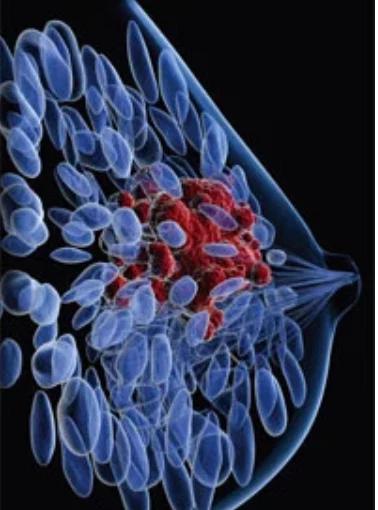Article
Presence of ctDNA, CTCs Independently Linked With Early-Stage TNBC Recurrence
Author(s):
A new, recently patented liquid biopsy device designed to detect small amounts of genetic and cellular material from tumors in the bloodstream of patients with early-stage, recurrent triple negative breast cancer, following neoadjuvant chemotherapy, has shown great accuracy and sensitivity.

A new, recently patented liquid biopsy device designed to detect small amounts of genetic and cellular material from tumors in the bloodstream of patients with early-stage, recurrent triple negative breast cancer (TNBC), following neoadjuvant chemotherapy, has shown great accuracy and sensitivity, according to results of a study published in JAMA Oncology.1
Among the 196 women who provided samples for the liquid biopsy, investigators found a significant association between inferior distant disease-free survival (DDFS) and detection of circulating tumor DNA (ctDNA).2 Results showed that ctDNA detection was significantly associated with inferior DDFS at 32.5 months versus not reached (HR, 2.99; 95% CI, 1.38-6.48; P = .006).
At the 24-month mark, DDFS probability was 56% for patients who were ctDNA-positive versus 81% for ctDNA-negative patients. Likewise, there was a notable association between detection of ctDNA and inferior disease-free survival (DFS; HR, 2.67; 95% CI, 1.28-5.57; P = .009), as well as inferior overall survival (OS; HR, 4.16; 95% CI,1.66-10.42; P = .002). It was also found that patients who tested positive for both circulating tumor cells (CTCs) and ctDNA had inferior DDFS compared with those who tested negative for ctDNA and CTC (median DDFS, 32.5 months vs not reached; HR, 5.29; 95% CI, 1.50-18.62; P = .009). At 24-months, patients who were positive for ctDNA had a DDFS probability of 52%, while patients who were both ctDNA negative and CTC negative had a DDFS probability of 89%.
“These circulating markers were more predictive of relapse than any other commonly used clinical marker on the planet,” said Milan Radovich, an associate professor at the IU Simon Comprehensive Cancer Center, in a press release. “It’s more predictive than tumor size, grade, stage or lymph node status.”
Current methods for diagnosing cancer often involve invasive biopsy, and noninvasive methods, such as blood tests, are warranted. This preplanned secondary analysis, which took place from March 26, 2014 to December 18, 2018, was part of the multicenter, randomized, phase 2 BRE12-158 trial, and compared the use of post-neoadjuvant genomically-directed therapy with physician’s choice of treatment in patients with early-stage TNBC following neoadjuvant chemotherapy. The ctDNA analysis with survival was performed on 142 patients, while the CTC analysis with survival was performed on 123 patients, with a median follow-up of 17.2 months.
CTC cells are particularly rare and difficult to detect, with only 3 or 4 cells being present in a blood sample of 8 milliliters. The liquid biopsy device developed to perform the analysis on liquid biopsy samples isolates CTCs, and investigators then mixed the liquid biopsy with magnetic particles that are functionalized with antibodies in order to help recognize the cells they're supposed to be targeting. Upon running the sample through a microfluidic device, a magnetic field can attract and capture magnetic CTC cells.
“This is a particularly aggressive form of breast cancer, and recurrence of the disease tends to be high,” Cagri A. Savran, a professor of mechanical engineering at Purdue University, stated in a press release. “So, after their chemotherapy, we took blood samples from the patients to see if presence of [circulating tumor DNA and CTCs] were an accurate marker of disease relapse.”
By utilizing ctDNA and CTCs in tandem, investigators determined this yielded additional information to help increase sensitivity and discriminatory capacity when testing patients for TNBC recurrence. Based on these findings, investigators were able to conclude that ctDNA and CTC were each independently associated with disease recurrence and represents an important stratification factor for post-neoadjuvant research in the future.
“Imagine you’re a patient with this triple-negative breast cancer. Even if chemotherapy and surgery were successful, life can be a nightmare,” Radovich concluded. “They have told us that every headache or back pain incites fear that their cancer is coming back. With this technology, we can offer a more definitive answer for both physicians and patients.”
References:
- Radovich M, Jiang G, Hancock BA. Association of circulating tumor DNA and circulating tumor cells after neoadjuvant chemotherapy with disease recurrence in patients with triple-negative breast cancer. JAMA Oncol. 2020; e202295. doi:10.1001/jamaoncol.2020.2295
- Liquid biopsy tech contributes to successful clinical trial for detecting breast cancer recurrence. News release. Purdue University. July 27, 2020. Accessed August 4, 2020. https://bit.ly/2D9JMlH









